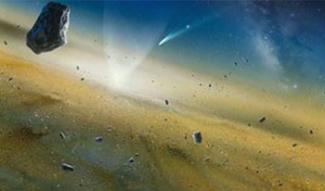Description
Protoplanetary discs are the sites of planetary formation: they provide the dust and gas building blocks to form the exo-planetary systems observed around main sequence stars (see e.g., Testi et al. 2014). According to the analytical theory of Lynden-Bell & Pringle (1974), the gas in protoplanetary discs evolve under the influence of an effective viscosity, conserving angular momentum. Consequently, discs are getting larger with time, a process known as viscous spreading. Dust behaves differently due to the presence of radial drift: the gas exerts a drag force on the dust, that loses angular momentum and quickly drifts inwards towards the star (Weidenschilling 1977). A key problem is to understand how efficient can dust radial drift be. Indeed, because of radial drift we should expect the dust disc size to shrink in time and eventually, due to the very short timescales involved, the dust disc to disappear (Appelgren et al. 2020). However, discs are still observed at a typical age of a few Myr. Thanks to new generation instruments such as ALMA, dust and gas radii of discs can be measured for many young regions (see e.g., Sanchis et al. 2021). In this talk I will show tests of disc evolution models studying the secular evolution of the ratio between the observed dust and gas radius, to test the efficiency of radial drift. Our discs models are evolving considering viscous evolution and the two-population dust model of Birnstiel et al. 2012, that includes grain growth, fragmentation, and radial drift. We also included the feedback of dust onto gas (Laibe & Price 2014). To evaluate the flux of the models we use the radiative transfer code RADMC (Dullemond et al. 2012). Once evaluated the dust and gas radii, we investigate how their ratio evolves as a function of the time. We tested different values of initial disc mass, scale radius and viscosity, covering the range of reasonable values found in the Literature, and we compared our results with the observational findings of young star forming regions such as Lupus (Sanchis et al. 2021). I will show that, for a wide range of initial conditions of the discs, the ratio between the dust and gas radii quickly (after about a Myr) becomes very large ( >5) due to the presence of radial drift, pointing out that radial drift is too efficient in the models. To solve this odd, substructures, routinely resolved in bright, large discs, must be present in most of the sources, although unresolved.

